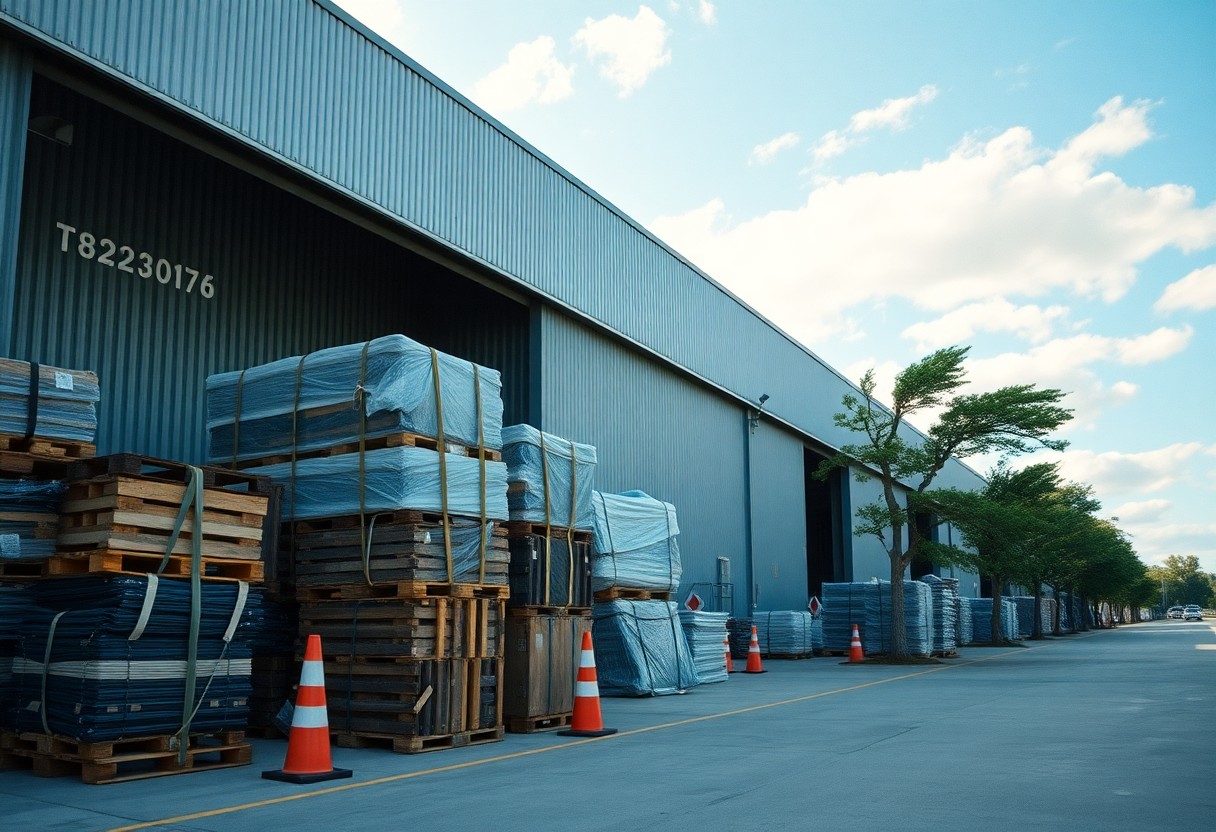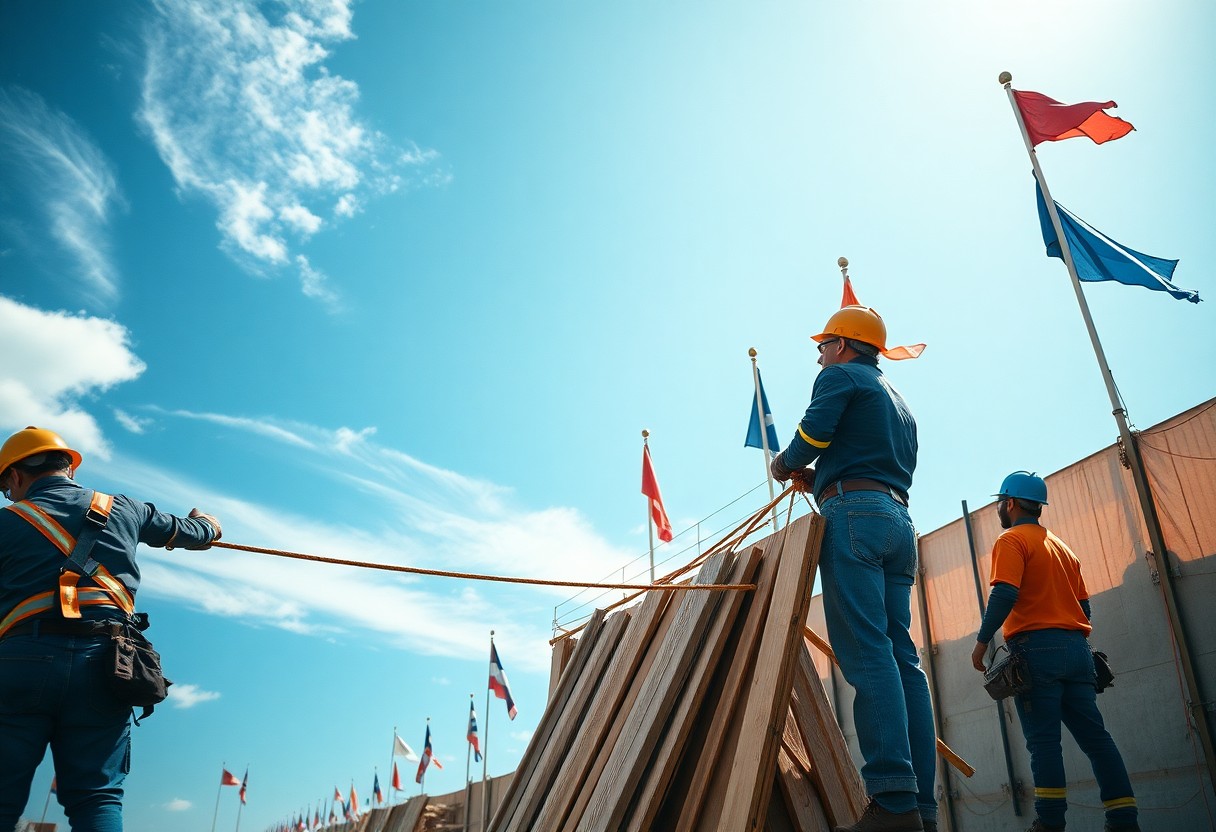Many individuals overlook the hazards posed by high winds, which can lead to serious accidents if materials are not secured properly. It’s important to identify and secure loose items in your environment, as they can become hazardous projectiles. Additionally, using weighted anchors for outdoor materials can significantly reduce risks. Prioritizing safety during windy conditions protects not only your property but also ensures the well-being of others around you. Take action now to safeguard your workspace and community from potential wind-related accidents.
Key Takeaways:
- Secure all materials and equipment at heights to prevent them from being blown away by high winds.
- Establish designated areas for materials to reduce the risk of loose items during windy conditions.
- Conduct regular inspections of site safety measures and update protocols as wind conditions change.
Understanding High Winds
High winds occur when air moves rapidly across the Earth’s surface, often exceeding 25 miles per hour. These winds can be caused by various meteorological events, including thunderstorms, hurricanes, and cold fronts. You should be particularly alert during such conditions, as they are unpredictable and can intensify unexpectedly. Knowing the forecast and monitoring local weather updates can keep you informed of any potential wind hazards that may impact your work environment.
Definition and Causes
High winds are defined as sustained winds exceeding 25 miles per hour or gusts that reach 35 miles per hour or more. They are often caused by severe weather systems, such as storms or pressure changes that occur when cold and warm fronts collide. Understanding these dynamics is key to anticipating when conditions may pose a threat to your safety and the stability of materials on site.
Impact on Worksites
High winds can have a significant impact on worksites, posing a risk to both personnel and structures. Loose materials can become projectiles, causing injury or damage. Equipment can be tipped or blown over, increasing the likelihood of accidents. Unsecure scaffolding and tarps can lead to workplace hazards, often resulting in delays and increased costs. Your awareness and preparedness are vital in mitigating these risks.
For example, according to the Occupational Safety and Health Administration (OSHA), wind speeds above 20 miles per hour can destabilize tall equipment and scaffolding. Additionally, over a five-year period, incidents related to high winds on construction sites resulted in numerous injuries and several fatalities. It’s vital to conduct regular checks on equipment and materials, ensuring everything is properly secured before high winds are forecasted. Implementing robust safety protocols, such as training workers on emergency procedures in windy conditions, can significantly reduce the likelihood of accidents and enhance overall site safety.
Risks Associated with High Winds
High winds present a range of hazards that can undermine safety on job sites. You face increased risks, including flying debris and structural damage, which can lead to serious injuries or costly repairs. Understanding these dangers equips you to take the appropriate safety measures.
Flying Debris
When winds reach elevated speeds, unsecured materials can become projectiles, causing injury or damage to nearby persons or property. Clear surroundings and secure all items, especially smaller tools and materials, to mitigate this risk.
Structural Damage
High winds can exert enormous pressure on structures, leading to potential collapses or failure. This stress is particularly significant for temporary structures like tents or scaffolding that lack the same durability as permanent buildings. The risk of compromised integrity is heightened during gusty conditions.
For example, a report from the National Weather Service notes that winds exceeding 50 mph can severely damage structures, causing roof panels to dislodge or walls to buckle. Protect your site’s integrity by routinely inspecting your structures and implementing reinforcements where necessary, especially during storm warnings or forecasts of high winds. Investing in quality materials and securing them properly will significantly reduce your liability and keep everyone safer.
Securing Materials
Properly securing materials during high winds is important to avoid accidents and injuries. Ensure that all materials, tools, and equipment are anchored or stored in a designated area, minimizing the risk of being displaced by strong gusts. Utilize methods that consider both the type of material and its weight to effectively hold everything in place. As a general rule, always assess the potential for wind in your environment and adjust your securing strategies accordingly.
Recommended Practices
Implement a combination of tie-downs, weights, and enclosures as part of your securing strategy. Use strong tarps for lightweight materials to prevent them from becoming airborne and damaging property or injuring people. Regularly inspect all securing mechanisms to ensure they remain effective under changing wind conditions. Keep an inventory of materials that require extra attention and have backup securing plans in place during particularly windy conditions.
Tools and Equipment
Utilize a variety of tools and equipment to secure materials effectively. Items such as straps, bungee cords, and anchoring stakes can significantly enhance stability. Consider investing in heavy-duty tarps and securing cable systems for larger loads. Portable windbreaks can also help shield lighter materials from wind exposure.
Using tools like ratchet straps provides enhanced tension and security for loads that may shift in high winds. Complement these with sandbags or weighted objects to keep materials grounded. For larger materials, consider using earth anchors, which dig into the ground to provide sturdy support. Assess the working environment for any unique features or vegetation that can aid in securing materials, leveraging their presence for maximum effectiveness. Always evaluate the strength and condition of your tools before use to ensure reliability.
Employee Safety Measures
Implementing effective employee safety measures during high winds is vital to maintain a secure job site. Begin by ensuring that all employees are equipped with proper personal protective equipment (PPE) to shield against debris. Develop a plan for securing materials, tools, and equipment, and conduct regular inspections to identify potential hazards. Clear communication lines among team members about safety expectations will enhance overall preparedness, providing a proactive approach to risk mitigation.
Training and Awareness
Training and awareness play a pivotal role in protecting your team from high wind hazards. Holding regular training sessions allows you to inform your employees about the dangers they may encounter and the specific procedures for maintaining safety. Utilize real scenarios and case studies to illustrate potential risks and ensure that your team knows how to respond to high wind conditions effectively.
Emergency Protocols
Your emergency protocols must be clearly defined and practiced to ensure rapid responses in high wind situations. Establish a designated safe area for employees to retreat to during severe weather events, and ensure that communication devices are available for immediate coordination. Provide easy access to the emergency contacts and resources, like weather alerts, so that your team can quickly react if conditions deteriorate.
Effective emergency protocols include drills that simulate high wind scenarios, allowing you to assess your team’s preparedness. For instance, consider conducting monthly exercises where employees practice securing materials and evacuating to safe areas when wind speed exceeds a predetermined threshold. This kind of training fosters not only familiarity with emergency procedures but also confidence in your team’s ability to handle real-life situations, ultimately enhancing overall workplace safety.
Legal and Regulatory Considerations
Understanding legal and regulatory considerations is important for maintaining safety during high winds. Compliance with local, state, and federal regulations can mitigate risks associated with high winds. Familiarize yourself with the relevant standards and how they apply to your work site. For comprehensive insights, refer to the TOOLBOX TALK High Winds, which provides valuable guidelines.
OSHA Guidelines
The Occupational Safety and Health Administration (OSHA) offers guidelines that outline safety measures to take during high winds. You must ensure that your work site adheres to these protocols, which address wind-related hazards and mandate the proper securing of materials. Adhering to OSHA’s standards protects both your crew and your company from legal repercussions.
Employer Responsibilities
As an employer, your responsibilities extend beyond providing safety equipment. You must conduct regular risk assessments and ensure all employees are trained on how to secure materials effectively during high winds. Implementing preventive measures not only protects your workers but also reduces liability in the event of an accident.
This responsibility includes creating comprehensive training programs that cover potential wind hazards, demonstrating proper securing techniques, and ensuring safety equipment is accessible and suitable for high-wind conditions. Conducting frequent safety drills reinforces this training and enables you to spot areas needing improvement, ultimately fostering a safer work environment.

Case Studies and Lessons Learned
Real-life examples highlight the impact of high winds on worksite safety. An analysis of incidents reveals that 20% of material failures during strong winds led to serious injuries. One case reported 15 injuries due to unsecured scaffolding, while another noted that 30% of accidents were linked to flying debris from construction sites. Enhanced tracking of winds led to a 40% decrease in incidents after implementing safety protocols. These statistics emphasize the necessity of strict enforcement of safety measures.
- Incident A: 15 injuries from unsecured scaffolding, resulting in $100K in damages.
- Incident B: 20 accidents related to flying debris, with 5 requiring hospitalization.
- Regulation C: Safety compliance improved site conditions, decreasing accidents by 40%.
- Study D: Workers’ compensation claims reduced by 25% post-intervention.
Successful Interventions
Implementing effective safety measures can significantly reduce accidents during high winds. For instance, a site that adopted harnesses and secure tethering systems saw a 70% reduction in incidents. Additionally, consistent weather monitoring helped teams prepare for sudden gusts, leading to greater compliance with securing protocols. These proactive steps are key to maintaining a safer work environment.
Common Mistakes to Avoid
A common oversight during high winds is neglecting to secure materials adequately. Relying solely on temporary barriers or failing to perform regular checks for integrity can lead to significant hazards. At times, workers may underestimate wind speeds, believing that conditions are safe enough to forgo proper securing measures.
Many workers assume loose items on-site pose minimal risks during gusts, but that perception can lead to dangerous outcomes. Failure to secure tools, scaffolding, and other materials often results from inadequate training or complacency. It’s imperative to implement regular safety drills to instill caution and encourage vigilance among workers. High winds can shift unexpectedly, so continuously assessing conditions and securing all materials is vital to ensuring a safe work environment. Avoiding these common mistakes will enhance workplace safety and reduce risk during high-wind conditions.
Conclusion
With this in mind, you must prioritize securing materials during high winds to prevent accidents and ensure safety on-site. By taking proactive measures such as anchoring or storing items properly, you protect not only yourself but also your colleagues and the surrounding community. Stay vigilant and regularly assess weather conditions, as timely actions can significantly mitigate risks associated with fluctuating winds.
FAQ
Q: What precautions should be taken for securing materials during high winds?
A: Ensure all loose materials, tools, and equipment are properly stored or secured. Use straps, weights, or tethering methods to prevent items from becoming airborne. Regularly inspect storage areas for stability.
Q: How can high winds affect construction sites?
A: High winds can create hazardous conditions by causing materials to shift, become airborne, or fall from heights. This can lead to injuries, damage to equipment, and delays in construction. Implementing safety protocols is necessary for minimizing risks.
Q: What specific materials are most at risk during high wind events?
A: Lightweight materials such as tarps, plywood sheets, scaffolding, and loose debris are particularly vulnerable to being lifted or blown away. Secure these items to prevent accidents and ensure the safety of the work site and personnel.
